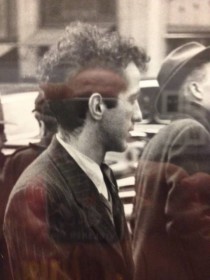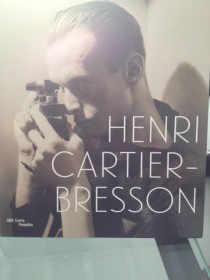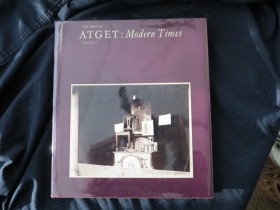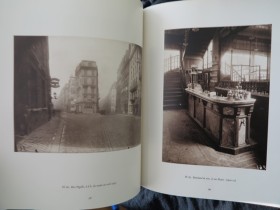Fotografen Jacob Holdt er tilbage i et fotografi han optog for fire årtier siden. Eller rettere han er tilbage det sted hvor han optog fotografiet. Det var et hus, hvor der boede en kvinde med sin lille søn. Nu er kvinden borte og alle spor efter hendes nænsomhed og omhu i hverdagene dengang. Sønnen er også væk, sporene som Holdt møder i huset er efter sønnens opløsning som menneske i en vanrøgt af barndomshjemmet som er en ruin omkring et mere end trist rod.
Jacob Holdt opsøger på den måde en suite scener fra sine optagelser dengang. De er bestemt ikke alle nedslående som denne, de fleste er opløftende fortsættelser af mødet for så længe siden, som var årene siden sidst ikke disse mange. Fotografiernes personer er der stadig i deres omgivelser og optagelserne kan fortsætte. På nogle måder som var intet hændt. Denne række møder er filmens vigtige story line. Det er den enkle arkitektur, jeg glæder mig til, når filmens instruktør Niels-Ole Rasmussen som det jeg hæfter mig ved i pressemeddelelsen fortæller denne hændelse fra den langvarige forberedelse: ”Jeg glemmer nemlig aldrig den dag, Jacob kom forbi med en uskyldigt udseende disc. Hvad er det, spurgte jeg? Det er billederne, svarede Jacob. Disc’en gemte 15.000 billeder, som vagabonden Jacob fotograferede i USA fra 1971-75. Kun et fåtal er siden blevet verdensberømte i Amerikanske Billeder.”
Niels-Ole Rasmussen er forfatter, erfaren journalist og flittig tv-tilrettelægger, og her denne dag havde han altså i hånden et arkiv med tusinder optagelser af en fotograf, som i sin tid blev banebrydende for en ny dokumentarisk linje i den fotografiske kunst. Det var en gave til hans nye værk, og det var en forpligtende opgave.
Titlen Jacob Holdt: Mit liv i billeder rejser spørgsmålet om det her er en nøgtern tv-biografi eller et lyrisk reflekterende filmessay? Og titlen rejser dernæst med sit kolon autorspørgsmålet, hvem har egentlig skrevet, instrueret, tilrettelagt? Hvad er det for et greb Niels-Ole Rasmussen har lagt ned over værket ved med et kolon at forvirre mig, så jeg bliver usikker på hvorfra historien fortælles? Og hvorfor skal jeg i netop dette allerførste øjeblik være usikker på, om filmen sådan rigtig er instruktørens værk. Er Jacob Holdt iagttaget, beskrevet, skildret af Niels-Ole Rasmussen eller er han ikke?
Jeg må nu jeg har set filmen svare både nej og ja. For store deles vedkommende er det den dokumentariske fotograf og opdagelsesrejsende Holdt som fortæller, men han har haft journalisten Rasmussen til at hjælpe sig, altså en specialist i tv-dokumentar, så forbillederne for deres filmværk hentes her, æstetikken hentes herfra. Og underholdningskravet herfra griber formende ind på grundmaterialet, på anvendelsen af de 15.000 dokumentariske fotografier fra 1971-75 på disc’en, som udveksledes den dag Niels-Ole Rasmussen aldrig glemmer.
Til dette materiale af international kunsthistorisk interesse lægges fra den tv-dokumentariske tradition rekonstruktionen, for eksempel en scene hvor Jacob Holdt skal demonstrere hvordan han arbejdede som prositueret i rige villaer i sydstaternes herregårdsstil som for mig at se ender i forlorne smil og dementerende fnis, og tv-reportagen, for eksempel et afsnit om den troværdighedshistorie som i forbindelse med en udstillling på Charlottenborg rejstes i Weekendavisagen som jeg oplever tabes på gulvet i ubeslutsomme billeder og i en dialog som forudsætter underforstået viden. Men, men, Niels-Ole Rasmussen og Jacob Holdt laver også tre store afsnit bygget af ægte filmscener som er hele filmen værd:
Jacob Holdt opsøger en kvinde fra fotografierne, en kvinde fra dengang, Marly Sockol, kæresten fra begyndelsen af 70’erne. De var sammen som forelskede aktive kommunister, og det var svært og farligt for følelserne. Men i mødet viser hun i en lang ofte munter samtale, med et blik som ikke sådan kan glemmes på 45 år afstand den unge kvinde som Jacob Holdt i den grad forståeligt måtte elske. Endnu til filmlitteraturen en skildring af forelskelsens væsen.
Og han opsøger en anden kæreste fra dengang, Merrilyn Jones hedder hun, og på fotografiet fra dengang sidder hum i badekarret; hun er ung og frigjort og modig. Det er et berømt fotografi tror jeg. Nu mere end fire årtier mødes de, han har kameraet fra dengang med, vil gentage opstillingen, overtaler hende flirtende og hun går med til det flirtende, mens de glade og oprømte diskuterer: var vi kærester, eller var vi ikke? Atter til filmlitteraturen en skildring af erotikkens væsen.
Og han opsøger klanlederen Robert Moore, sin gamle ven som var leder i Ku Klux Klan. Nu skal Robert Moore giftes og Jacob Holdt som er opdraget i en jysk præstegård står for den hellige handling. Bryllupstalen er helt sædvanlig, den slutter som den skal med Paulus’ ord om kærligheden, som aldrig ophører, og den er et ganske usædvanligt personligt vidnesbyrd om forståelse og accept af det frastødende hos andre og hos sig selv. Atter til filmlitteraturen en skildring af venskabets væsen.
Her i dette afsnit er Jacob Holdts tale så vigtig. Den er en af de tre taler som klipperen Mikkel Sangstad har anbragt som kloge markører i forløbet. Jacob Holdt samler således sine livsanskuelsesmæssige erfaringer og konklusioner i form af taler, et andet sted hos gamle venner i Skotland, venner af en helt anden slags, holder han en bordtale og endelig under et besøg helt alene ved faderens grav en tale til ham. Altså bryllupstale, tale ved bordet, tale ved graven.
Således fastlægger Sangstad i klippet fra begyndelsen af filmen en fasthed i afsnitinddeling og rytme, men det opgives desværre, han går efterhånden i fortællingen tilbage og samler op uden det forudsættes i rammen, som jeg først tror er den nutidige samtale med hustruen ved spisebordet, men det forbliver udefineret og udviskes så jeg efterhånden ikke ved hvor jeg er henne i et oplever jeg næsten tilfældigt reportagestof, men tænkt som informerende og underholdende nødvendighed.
Tv-dokumentaræstetik, ugebladsæstetik, folkelig æstetik. Problemet med den folkelige fortællemåde er at når den havner i en ikke folkelig fortællers virksomhed, så bliver den uvægerlig påtaget, beregnende og kommer til at tale nedad, og det skinner ubehageligt igennem visse af hvad jeg på den måde tror er Niels-Ole Rasmussens dispositioner, valg og fravalg, men det sker derimod aldrig for Jacob Holdt selv; han er i sin kunst den egentlige folkelige fortællings håndværker.
For mig samler deres film Jacob Holdt: Mit liv i billeder sig således i en kerne af autentisk dokumentarisk filmarbejde i blot tre gribende afsnit klippet af filmscener, tre samvær med kvinder, som blev forladt, men aldrig glemt og tre kloge moralske taler, en bryllupstale, en bordtale og en gravtale.
Niels-Ole Rasmussen: Jacob Holdt: Mit liv i billeder, Danmark 2016. Anmeldelse: 4/6 penne. Premiere med DOXBIO 5. oktober i mange biografer: http://www.doxbio.dk/movie-archive/jacob-holdt-mit-liv-i-billeder/
http://www.dfi.dk/faktaomfilm/film/da/96882.aspx?id=96882
SYNOPSIS
Vagabond og fotograf Jacob Holdt tvinges til at opsøge sandheden om sin eventyrlige skæbne. Jacobs ekstreme ja-filosofi kastede ham i armene på sit livs store kærlighed, USA. Her vandrede den unge præstesøn – fra Ku Klux Klan og mordere til de sorte på bunden af den amerikanske drøm. Jacobs frygtløse tilgang til livet førte ham ud i kampen for at forvandle racismens had til kærlighed mellem mennesker. Men hvilke indre dæmoner drev vagabonden fra sted til sted?
Publikum er med, når Jacob konfronterer fortidens synder og rydder op. Det er pinligt, når længst glemte hemmeligheder afsløres; det er berusende, når gamle flammer pludselig selvantænder i glødende lidenskab; det er brutalt, når Døden høster i kærlighedens have; det er generøst, gavmildt og lattermildt. Kan livets lange tråde flettes som vagabondens eget skæg?
Denne roadmovie er en sanselig hyldest til Amerikanske Billeder, til rejsen, til eventyret, til visdommen og ikke mindst til kærligheden. Unge Jacob Holdt skulle være præst, men gjorde oprør. I begyndelsen af 70’erne flygtede han til USA. Som vagabond levede Jacob efter én regel: sig ja til alle mennesker. Oplevelserne blev til Amerikanske Billeder. Nu vender Jacob tilbage for at søge sandheden bag sin eventyrlige skæbne. (Line Bilenberg)






